Tetracycline Molecularly Imprinted Fluorescent Sensor Based on Tomato Stalk-Derived Carbon Dots
Highlights
- Novel carbon dots with excellent fluorescence were prepared from agricultural waste tomato straw.
- A fluorescence sensor made of CDs@SiO2-MIPs was constructed via molecularly imprinted SiO2-confined carbon dots.
- The developed sensor exhibited high selectivity, a wide linear range, and a low detection limit for TC detection.
Abstract
1. Introduction
2. Materials and Methods
2.1. Materials
2.2. Apparatus
2.3. Preparation of CDs
2.4. Preparation of CDs@SiO2-MIPs
2.5. Fluorescent Sensing of TC
3. Results and Discussion
3.1. Characterization of CDs
3.2. Characterization of CDs@SiO2-MIPs
3.3. Optimization of the Sensor
3.4. Fluorescence Detection of CDs@SiO2-MIPs Toward TC
3.5. Mechanism of CDs@SiO2-MIPs for TC Detection
3.6. Selectivity, Anti-Interference Ability, and Stability of the CDs@SiO2-MIP Sensor
3.7. Comparison with MIP-Based Sensors for TC Detection
4. Conclusions
Supplementary Materials
Author Contributions
Funding
Institutional Review Board Statement
Informed Consent Statement
Data Availability Statement
Conflicts of Interest
References
- Kaur, I.; Batra, V.; Kumar Reddy Bogireddy, N.; Torres Landa, S.D.; Agarwal, V. Detection of organic pollutants, food additives and antibiotics using sustainable carbon dots. Food Chem. 2023, 406, 135029. [Google Scholar] [CrossRef] [PubMed]
- Wang, M.; Xin, D.; Zhang, W.; Luo, D.; Tan, G. Defects and plasma Ag co-modified S-scheme Ag/NVs-CN/Bi2O2-δCO3 heterojunction with multilevel charge transfer channels for boosting full-spectrum-driven degradation of antibiotics. J. Alloys Compd. 2024, 970, 172672. [Google Scholar] [CrossRef]
- Yang, W.; Cao, L.; Lu, H.; Huang, Y.; Yang, W.; Cai, Y.; Li, S.; Li, S.; Zhao, J.; Xu, W. Custom-printed microfluidic chips using simultaneous ratiometric fluorescence with “Green” carbon dots for detection of multiple antibiotic residues in pork and water samples. J. Food Sci. 2024, 89, 5980–5992. [Google Scholar] [CrossRef]
- Liu, J.; Yue, Y.; Wang, W.; Tan, F.; Xia, H.; Wang, X.; Qiao, X.; Wong, P.K. Facile one-step synthesis of 3D hierarchical flower-like magnesium peroxide for efficient and fast removal of tetracycline from aqueous solution. J. Hazard. Mater. 2020, 397, 122877. [Google Scholar] [CrossRef]
- Yu, L.; Chen, H.; Yue, J.; Chen, X.; Sun, M.; Tan, H.; Asiri, A.M.; Alamry, K.A.; Wang, X.; Wang, S. Metal–organic framework enhances aggregation-induced fluorescence of chlortetracycline and the application for detection. Anal. Chem. 2019, 91, 5913–5921. [Google Scholar] [CrossRef]
- Hamscher, G.; Sczesny, S.; Höper, H.; Nau, H. Determination of persistent tetracycline residues in soil fertilized with liquid manure by high-performance liquid chromatography with electrospray ionization tandem mass spectrometry. Anal. Chem. 2002, 74, 1509–1518. [Google Scholar] [CrossRef] [PubMed]
- Zhou, Q.; Zhang, Y.; Wang, N.; Zhu, L.; Tang, H. Analysis of tetracyclines in chicken tissues and dung using LC–MS coupled with ultrasound-assisted enzymatic hydrolysis. Food Control 2014, 46, 324–331. [Google Scholar] [CrossRef]
- Wang, Y.; Zhao, X.; Zhang, M.; Sun, X.; Bai, J.; Peng, Y.; Li, S.; Han, D.; Ren, S.; Wang, J.; et al. Immunosorbent assay based on upconversion nanoparticles controllable assembly for simultaneous detection of three antibiotics. J. Hazard. Mater. 2021, 406, 124703. [Google Scholar] [CrossRef]
- Liao, S.; Liu, J.; Luo, J.; Wang, S.; Li, Y.; Li, Q.; Chen, S.; Wang, G. A ratio fluorescence probe by one-stage process for selectivity detection of tetracycline. Opt. Mater. 2022, 134, 113160. [Google Scholar] [CrossRef]
- Liu, Y.; Xiao, Y.; Yu, M.; Cao, Y.; Zhang, Y.; Zhe, T.; Zhang, H.; Wang, L. Antimonene quantum dots as an emerging fluorescent nanoprobe for the pH-mediated dual-channel detection of tetracyclines. Small 2020, 16, 2003429. [Google Scholar] [CrossRef]
- Liang, N.; Hu, X.; Li, W.; Wang, Y.; Guo, Z.; Huang, X.; Li, Z.; Zhang, X.; Zhang, J.; Xiao, J.; et al. A dual-signal fluorescent sensor based on MoS2 and CdTe quantum dots for tetracycline detection in milk. Food Chem. 2022, 378, 132076. [Google Scholar] [CrossRef]
- Guo, Y.; Cai, Z. Ascorbic acid stabilized copper nanoclusters as fluorescent probes for selective detection of tetracycline. Chem. Phys. Lett. 2020, 759, 138048. [Google Scholar] [CrossRef]
- Zou, T.; Li, S.; Yao, G.; Qu, R.; Yang, W.; Wang, H.; Tan, W.; Yang, M. Highly photoluminescent tryptophan-coated copper nanoclusters based turn-off fluorescent probe for determination of tetracyclines. Chemosphere 2023, 338, 139452. [Google Scholar] [CrossRef] [PubMed]
- Li, C.; Ji, Y.; Shi, Y.; Xu, X.; Bao, L.; Cui, M.; Tian, Z.; Zhao, Z. A smart Zn-MOF-based ratiometric fluorescence sensor for accurate distinguish and optosmart sensing of different types of tetracyclines. Appl. Surf. Sci. 2023, 640, 158442. [Google Scholar] [CrossRef]
- Liu, L.; Chen, Q.; Lv, J.; Li, Y.; Wang, K.; Li, J.-R. Stable metal–organic frameworks for fluorescent detection of tetracycline antibiotics. Inorg. Chem. 2022, 61, 8015–8021. [Google Scholar] [CrossRef]
- Gan, Z.; Hu, X.; Xu, X.; Zhang, W.; Zou, X.; Shi, J.; Zheng, K.; Arslan, M. A portable test strip based on fluorescent europium-based metal–organic framework for rapid and visual detection of tetracycline in food samples. Food Chem. 2021, 354, 129501. [Google Scholar] [CrossRef]
- Shi, B.; Zhang, X.; Li, W.; Liang, N.; Hu, X.; Xiao, J.; Wang, D.; Zou, X.; Shi, J. An intrinsic dual-emitting fluorescence sensing toward tetracycline with self-calibration model based on luminescent lanthanide-functionalized metal-organic frameworks. Food Chem. 2023, 400, 133995. [Google Scholar] [CrossRef]
- Gao, Y.; Zhang, S.; Ge, B.; Zhao, H.; Jin, C.; Yan, H.; Zhao, L. Designing fluorescent covalent organic frameworks through regulation of link bond for selective detection of Al3+ and Ce3+. Spectrochim. Acta Part A Mol. Biomol. Spectrosc. 2025, 329, 125620. [Google Scholar] [CrossRef]
- Yu, Y.; Jin, Q.; Ren, Y.; Wang, Y.; Zhu, D.; Wang, J. Ratiometric fluorescent sensor based on europium (III)-functionalized covalent organic framework for selective and sensitive detection of tetracycline. Chem. Eng. J. 2023, 465, 142819. [Google Scholar] [CrossRef]
- Gan, J.; Chen, L.; Chen, Z.; Zhang, J.; Yu, W.; Huang, C.; Wu, Y.; Zhang, K. Lignocellulosic biomass-based carbon dots: Synthesis processes, properties, and applications. Small 2023, 19, 2304066. [Google Scholar] [CrossRef]
- Sawalha, S.; Silvestri, A.; Criado, A.; Bettini, S.; Prato, M.; Valli, L. Tailoring the sensing abilities of carbon nanodots obtained from olive solid wastes. Carbon 2020, 167, 696–708. [Google Scholar] [CrossRef]
- Yan, X.; Chen, J.-L.; Su, M.-X.; Yan, F.; Li, B.; Di, B. Phosphate-containing metabolites switch on phosphorescence of ferric ion engineered carbon dots in aqueous solution. RSC Adv. 2014, 4, 22318–22323. [Google Scholar] [CrossRef]
- Liu, Y.; Yang, H.; Huang, T.; Niu, L.; Liu, S. Recent advances of biomass-derived carbon dots with room temperature phosphorescence characteristics. Nano Today 2024, 56, 102257. [Google Scholar] [CrossRef]
- Qi, H.; Teng, M.; Liu, M.; Liu, S.; Li, J.; Yu, H.; Teng, C.; Huang, Z.; Liu, H.; Shao, Q.; et al. Biomass-derived nitrogen-doped carbon quantum dots: Highly selective fluorescent probe for detecting Fe3+ ions and tetracyclines. J. Colloid Interface Sci. 2019, 539, 332–341. [Google Scholar] [CrossRef]
- John, B.K.; John, N.; Korah, B.K.; Thara, C.; Abraham, T.; Mathew, B. Nitrogen-doped carbon quantum dots as a highly selective fluorescent and electrochemical sensor for tetracycline. J. Photochem. Photobiol. A Chem. 2022, 432, 114060. [Google Scholar] [CrossRef]
- Hu, J.; Liao, S.; Bai, Y.; Wu, S. Carbon dots derived from green jujube as chemosensor for tetracycline detection. J. Environ. Chem. Eng. 2024, 12, 112595. [Google Scholar] [CrossRef]
- Sun, X.; Jiang, M.; Chen, L.; Niu, N. Construction of ratiometric fluorescence MIPs probe for selective detection of tetracycline based on passion fruit peel carbon dots and europium. Microchim. Acta 2021, 188, 297. [Google Scholar] [CrossRef]
- Korah, B.K.; Chacko, A.R.; Mathew, S.; John, B.K.; Abraham, T.; Mathew, B. Biomass-derived carbon dots as a sensitive and selective dual detection platform for fluoroquinolones and tetracyclines. Anal. Bioanal. Chem. 2022, 414, 4935–4951. [Google Scholar] [CrossRef]
- Nie, Q.; Deng, J.; Xie, B.; Zhou, T. Highly efficient and sensitive detection of tetracycline in environmental water: Insights into the synergistic mechanism of biomass-derived carbon dots and N-methyl pyrrolidone solvent. Talanta 2024, 278, 126512. [Google Scholar] [CrossRef]
- Zhang, Z.; Hao, R.; Li, F.; Tian, S.; Xin, X.; Li, G.; Li, D. Emulsifying properties of cellulose nanocrystals with different structures and morphologies from various solanaceous vegetable residues. Food Chem. 2025, 463, 141241. [Google Scholar] [CrossRef]
- Jin, K.; Ran, Y.; Alengebawy, A.; Yang, G.; Jia, S.; Ai, P. Agro-environmental sustainability of using digestate fertilizer for solanaceous and leafy vegetables cultivation: Insights on fertilizer efficiency and risk assessment. J. Environ. Manag. 2022, 320, 115895. [Google Scholar] [CrossRef]
- Tang, H.; Han, W.; Fei, S.; Li, Y.; Huang, J.; Dong, M.; Wang, L.; Wang, W.; Zhang, Y. Development of acid hydrolysis-based UPLC–MS/MS method for determination of alternaria toxins and its application in the occurrence assessment in solanaceous vegetables and their products. Toxins 2023, 15, 201. [Google Scholar] [CrossRef]
- Chen, L.; Sun, S.; Yao, B.; Peng, Y.; Gao, C.; Qin, T.; Zhou, Y.; Sun, C.; Quan, W. Effects of straw return and straw biochar on soil properties and crop growth: A review. Front. Plant Sci. 2022, 13, 986763. [Google Scholar] [CrossRef] [PubMed]
- Chen, L.; Wang, X.; Lu, W.; Wu, X.; Li, J. Molecular imprinting: Perspectives and applications. Chem. Soc. Rev. 2016, 45, 2137–2211. [Google Scholar] [CrossRef] [PubMed]
- Li, C.; Ma, Y.; Fan, C.; Kang, J.; Ma, S. A highly efficient molecularly imprinted fluorescence sensor for selective and sensitive detection of tetracycline antibiotic residues in pork. J. Food Compos. Anal. 2024, 133, 106367. [Google Scholar] [CrossRef]
- Xu, Y.; Huang, T.; Wang, S.; Yan, Y. Mesoporous silica-based molecularly imprinted fluorescence sensor for the ultrafast and sensitive recognition of oxytetracycline. J. Food Compos. Anal. 2022, 108, 104427. [Google Scholar] [CrossRef]
- Qiu, H.; Gao, L.; Wang, J.; Pan, J.; Yan, Y.; Zhang, X. A precise and efficient detection of Beta-Cyfluthrin via fluorescent molecularly imprinted polymers with ally fluorescein as functional monomer in agricultural products. Food Chem. 2017, 217, 620–627. [Google Scholar] [CrossRef]
- Mukunzi, D.; Habimana, J.d.D.; Li, Z.; Zou, X. Mycotoxins detection: View in the lens of molecularly imprinted polymer and nanoparticles. Crit. Rev. Food Sci. Nutr. 2023, 63, 6034–6068. [Google Scholar] [CrossRef]
- Arabi, M.; Ostovan, A.; Li, J.; Wang, X.; Zhang, Z.; Choo, J.; Chen, L. Molecular imprinting: Green perspectives and strategies. Adv. Mater. 2021, 33, 2100543. [Google Scholar] [CrossRef]
- Ostovan, A.; Arabi, M.; Wang, Y.; Li, J.; Li, B.; Wang, X.; Chen, L. Greenificated molecularly imprinted materials for advanced applications. Adv. Mater. 2022, 34, 2203154. [Google Scholar] [CrossRef]
- Hosseini, M.; Ganjali, M.R.; Aboufazeli, F.; Faridbod, F.; Goldooz, H.; Badiei, A.; Norouzi, P. A selective fluorescent bulk sensor for lutetium based on hexagonal mesoporous structures. Sens. Actuators B Chem. 2013, 184, 93–99. [Google Scholar] [CrossRef]
- Amiri, A.; Faridbod, F.; Zoughi, S. An optical nanosensor fabricated by carbon dots embedded in silica molecularly imprinted polymer for sensitive detection of ceftazidime antibiotic. J. Photochem. Photobiol. A Chem. 2021, 408, 113111. [Google Scholar] [CrossRef]
- Xu, L.; Fang, G.; Pan, M.; Wang, X.; Wang, S. One-pot synthesis of carbon dots-embedded molecularly imprinted polymer for specific recognition of sterigmatocystin in grains. Biosens. Bioelectron. 2016, 77, 950–956. [Google Scholar] [CrossRef] [PubMed]
- Arkin, K.; Zheng, Y.; Bei, Y.; Ma, X.; Che, W.; Shang, Q. Construction of dual-channel ratio sensing platform and molecular logic gate for visual detection of oxytetracycline based on biomass carbon dots prepared from cherry tomatoes stalk. Chem. Eng. J. 2023, 464, 142552. [Google Scholar] [CrossRef]
- Zhou, T.; Halder, A.; Sun, Y. Fluorescent Nanosensor Based on Molecularly Imprinted Polymers Coated on Graphene Quantum Dots for Fast Detection of Antibiotics. Biosensors 2018, 8, 82. [Google Scholar] [CrossRef]
- Sun, Q.; Fu, L.; Yin, C.; Wu, M.; Liu, H.; Niu, N.; Chen, L. Construction of biomass carbon dots@molecularly imprinted polymer fluorescent sensor array for accurate identification of 5-nitroimidazole antibiotics. Sens. Actuators B Chem. 2022, 373, 132716. [Google Scholar] [CrossRef]
- Zhang, D.; Zhang, Y.; Li, K.; Wang, S.; Ma, Y.; Liao, Y.; Wang, F.; Liu, H. A smartphone-combined ratiometric fluorescence molecularly imprinted probe based on biomass-derived carbon dots for determination of tyramine in fermented meat products. Food Chem. 2024, 454, 139759. [Google Scholar] [CrossRef]
- Zhang, S.; Arkin, K.; Zheng, Y.; Ma, J.; Bei, Y.; Liu, D.; Shang, Q. Preparation of a composite material based on self-assembly of biomass carbon dots and sodium alginate hydrogel and its green, efficient and visual adsorption performance for Pb2+. J. Environ. Chem. Eng. 2022, 10, 106921. [Google Scholar] [CrossRef]
- Ren, Y.; Fan, Z. Synthesis of fluorescent probe based on molecularly imprinted polymers on nitrogen-doped carbon dots for determination of tobramycin in milk. Food Chem. 2023, 416, 135792. [Google Scholar] [CrossRef]
- Lin, Y.; Wang, C.; Li, L.; Wang, H.; Liu, K.; Wang, K.; Li, B. Tunable fluorescent silica-coated carbon dots: A synergistic effect for enhancing the fluorescence sensing of extracellular Cu2+ in rat brain. ACS Appl. Mater. Interfaces 2015, 7, 27262–27270. [Google Scholar] [CrossRef]
- Liu, J.; Li, R.; Qin, L.; Fu, D.; Wang, M.; Liu, W.; Liu, X. Carbon dot-based molecularly imprinted polymer fluorescent sensor for the detection of propranolol in plasma. Spectrochim. Acta Part A Mol. Biomol. Spectrosc. 2025, 329, 125590. [Google Scholar] [CrossRef]
- Murugan, K.; Jothi, V.K.; Rajaram, A.; Natarajan, A. Novel Metal-Free Fluorescent Sensor Based on Molecularly Imprinted Polymer N-CDs@MIP for Highly Selective Detection of TNP. ACS Omega 2021, 7, 1368–1379. [Google Scholar] [CrossRef]
- Zhang, Y.-Z.; Zhang, B.; Chen, Q.-Q.; Qin, L.; Hu, Y.-Q.; Bai, C.-H.; Li, Y.-L.; Qin, B. N-doped carbon dots coupled with molecularly imprinted polymers as a fluorescent sensor for ultrasensitive detection of genistein in soya products. Food Chem. 2023, 424, 136133. [Google Scholar] [CrossRef]
- Wang, J.; Sun, Y.; Wang, P.; Sun, Z.; Wang, Y.; Gao, M.; Wang, H.; Wang, X. A dual-emitting fluoroprobe fabricated by aloe leaf-based N-doped carbon quantum dots and copper nanoclusters for nitenpyram detection in waters by virtue of inner filter effect and static quenching principles. Anal. Chim. Acta 2024, 1289, 342182. [Google Scholar] [CrossRef] [PubMed]
- Serag, A.; Abduljabbar, M.H.; Alnemari, R.M.; Almalki, A.H. A novel spectrofluorimetric method for argatroban determination using Rhodamine B as an “on-off” fluorescent probe with Box-Behnken optimization and sustainability assessment. Sustain. Chem. Pharm. 2025, 48, 102193. [Google Scholar] [CrossRef]
- Peng, F.; Zhou, X.; Cheng, W.; Ma, J.; Jiang, H. A carbon dots probe for specific determination of cysteine based on inner filter effect. J. Anal. Chem. 2022, 77, 1141–1146. [Google Scholar] [CrossRef]
- Yuan, Y.; Jiang, J.; Liu, S.; Yang, J.; Zhang, H.; Yan, J.; Hu, X. Fluorescent carbon dots for glyphosate determination based on fluorescence resonance energy transfer and logic gate operation. Sens. Actuators B Chem. 2017, 242, 545–553. [Google Scholar] [CrossRef]
- Jalili, R.; Khataee, A.; Rashidi, M.-R.; Razmjou, A. Detection of penicillin G residues in milk based on dual-emission carbon dots and molecularly imprinted polymers. Food Chem. 2020, 314, 126172. [Google Scholar] [CrossRef]
- Li, K.; Wang, L.; Zhang, G.; Liu, J.; Du, Q. Metal-organic framework modified molecularly imprinted polymers-based sensor for fluorescent sensing of tetracycline in milk. J. Mol. Struct. 2024, 1303, 137598. [Google Scholar] [CrossRef]
- Liu, C.; Song, Z.; Pan, J.; Yan, Y.; Cao, Z.; Wei, X.; Gao, L.; Wang, J.; Dai, J.; Meng, M.; et al. A simple and sensitive surface molecularly imprinted polymers based fluorescence sensor for detection of λ-Cyhalothrin. Talanta 2014, 125, 14–23. [Google Scholar] [CrossRef]
- Wang, H.; Zhao, H.; Quan, X.; Chen, S. Electrochemical determination of tetracycline using molecularly imprinted polymer modified carbon nanotube-gold nanoparticles electrode. Electroanalysis 2011, 23, 1863–1869. [Google Scholar] [CrossRef]
- Chen, S.; Zhu, Y.; Han, J.; Zhang, T.; Chou, R.; Liu, A.; Liu, S.; Yang, Y.; Hu, K.; Zou, L. Construction of a molecularly imprinted sensor modified with tea branch biochar and its rapid detection of norfloxacin residues in animal-derived foods. Foods 2023, 12, 544. [Google Scholar] [CrossRef] [PubMed]
- Li, Y.; Li, H.; Wang, T.; Liu, G.; Wang, G.; Liu, M.; Pan, L.; He, J.; Li, K. Surface-molecularly imprinted ratiometric fluorescence sensor for fast, sensitive and selective determination of rhodamine 6G. Dye. Pigment. 2023, 219, 111602. [Google Scholar] [CrossRef]
- Wei, X.; Hao, T.; Xu, Y.; Lu, K.; Li, H.; Yan, Y.; Zhou, Z. Facile polymerizable surfactant inspired synthesis of fluorescent molecularly imprinted composite sensor via aqueous CdTe quantum dots for highly selective detection of λ-cyhalothrin. Sens. Actuators B Chem. 2016, 224, 315–324. [Google Scholar] [CrossRef]
- Fan, Y.J.; Wang, Z.G.; Su, M.; Liu, X.T.; Shen, S.G.; Dong, J.X. A dual-signal fluorescent colorimetric tetracyclines sensor based on multicolor carbon dots as probes and smartphone-assisted visual assay. Anal. Chim. Acta 2023, 1247, 340843. [Google Scholar] [CrossRef]
- Hu, X.; Zhao, Y.; Dong, J.; Liu, C.; Qi, Y.; Fang, G.; Wang, S. A strong blue fluorescent nanoprobe based on Mg/N co-doped carbon dots coupled with molecularly imprinted polymer for ultrasensitive and highly selective detection of tetracycline in animal-derived foods. Sens. Actuators B Chem. 2021, 338, 129809. [Google Scholar] [CrossRef]
- Mohammadnejad, M.; Alekasir, R. Sensitive and rapid determination of tetracycline antibiotic by carrot juice-derived carbon dots as a fluorescent probe. Luminescence 2024, 39, e4828. [Google Scholar] [CrossRef]
- Venugopalan, P.; Vidya, N. Microwave-assisted green synthesis of carbon dots derived from wild lemon (Citrus pennivesiculata) leaves as a fluorescent probe for tetracycline sensing in water. Spectrochim. Acta Part A Mol. Biomol. Spectrosc. 2023, 286, 122024. [Google Scholar] [CrossRef]
- Wang, Q.; Wu, Y.; Bao, X.; Yang, M.; Liu, J.; Sun, K.; Li, Z.; Deng, G. Novel fluorescence sensor for the selective recognition of tetracycline based on molecularly imprinted polymer-capped N-doped carbon dots. RSC Adv. 2022, 12, 24778–24785. [Google Scholar] [CrossRef]
- Xing, X.; Huang, L.; Zhao, S.; Xiao, J.; Lan, M. S,N-Doped carbon dots for tetracyclines sensing with a fluorometric spectral response. Microchem. J. 2020, 157, 105065. [Google Scholar] [CrossRef]
- Yan, W.; Wang, X.; Gao, X.; Zhao, L. A smart fluorescent colorimetric dual-response sensing for the determination of tetracycline antibiotics. J. Photochem. Photobiol. A Chem. 2024, 447, 115217. [Google Scholar] [CrossRef]
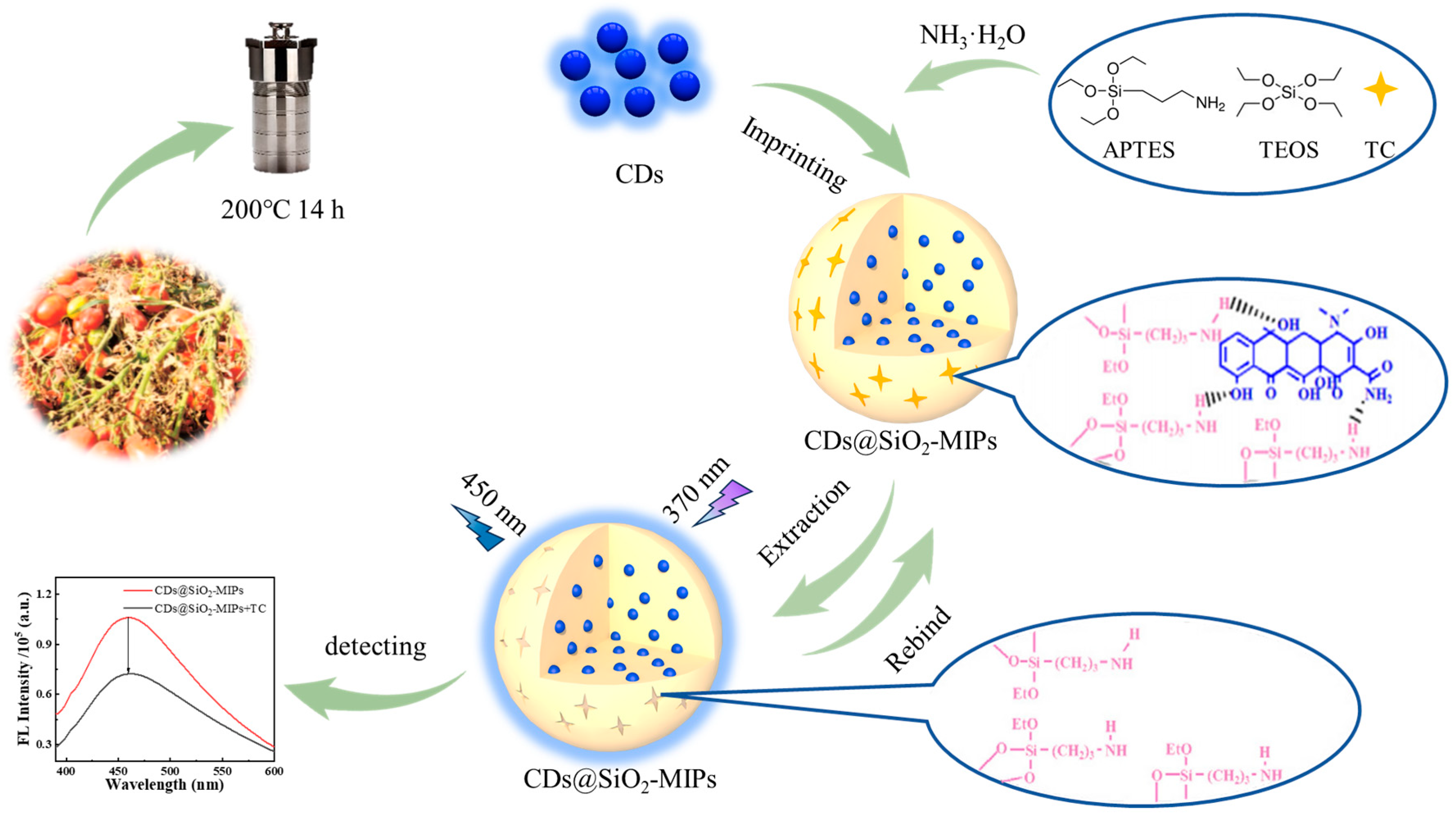

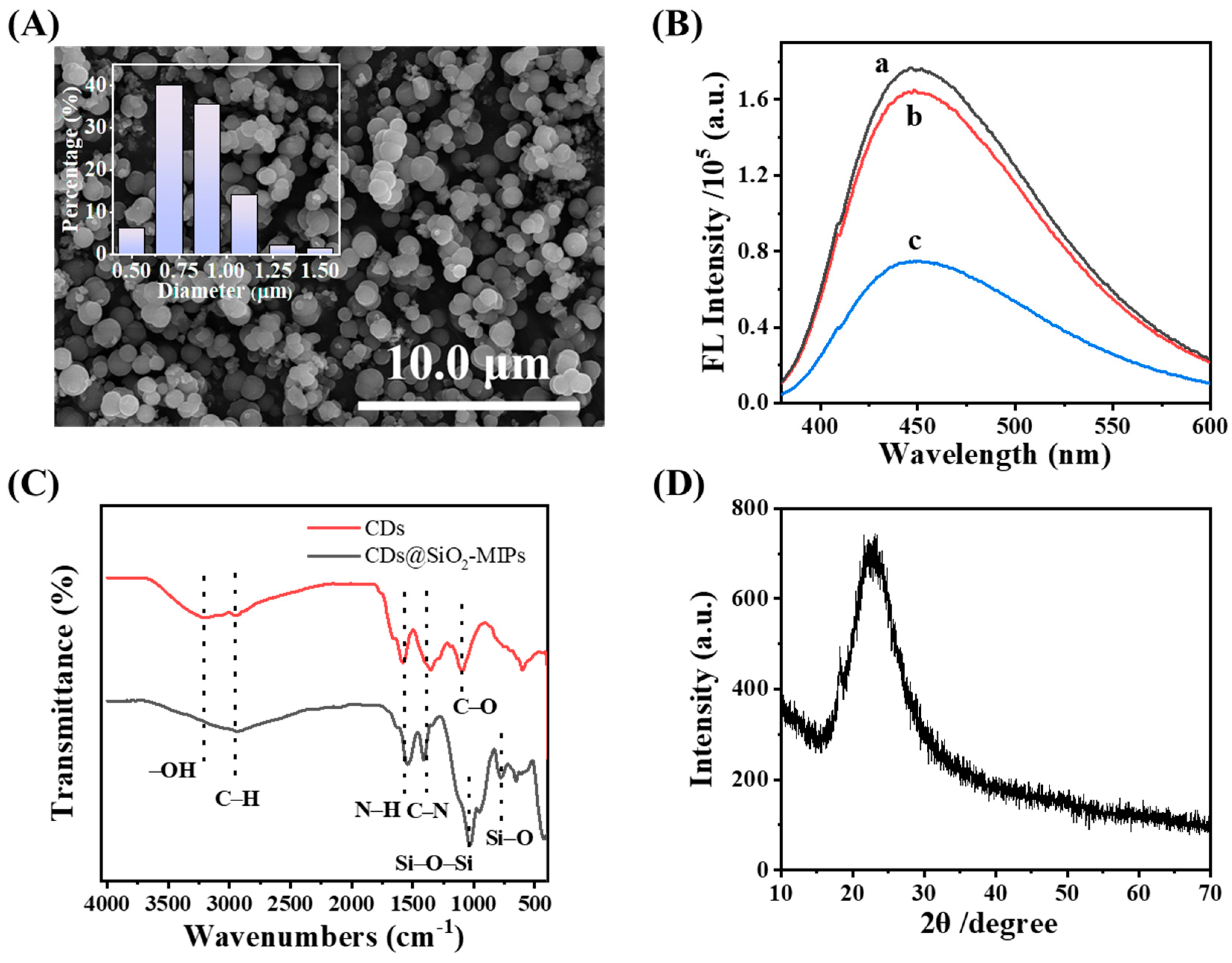
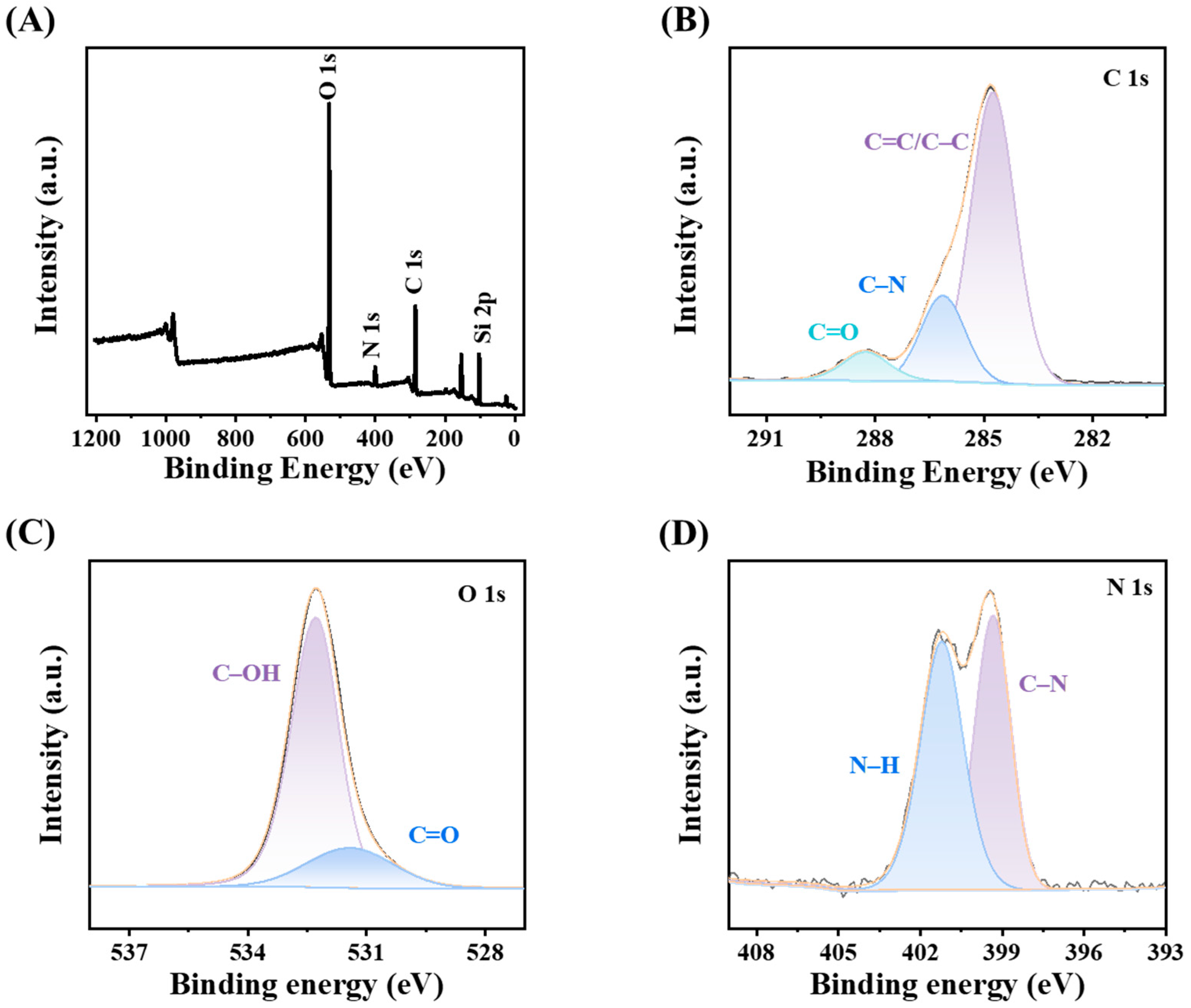
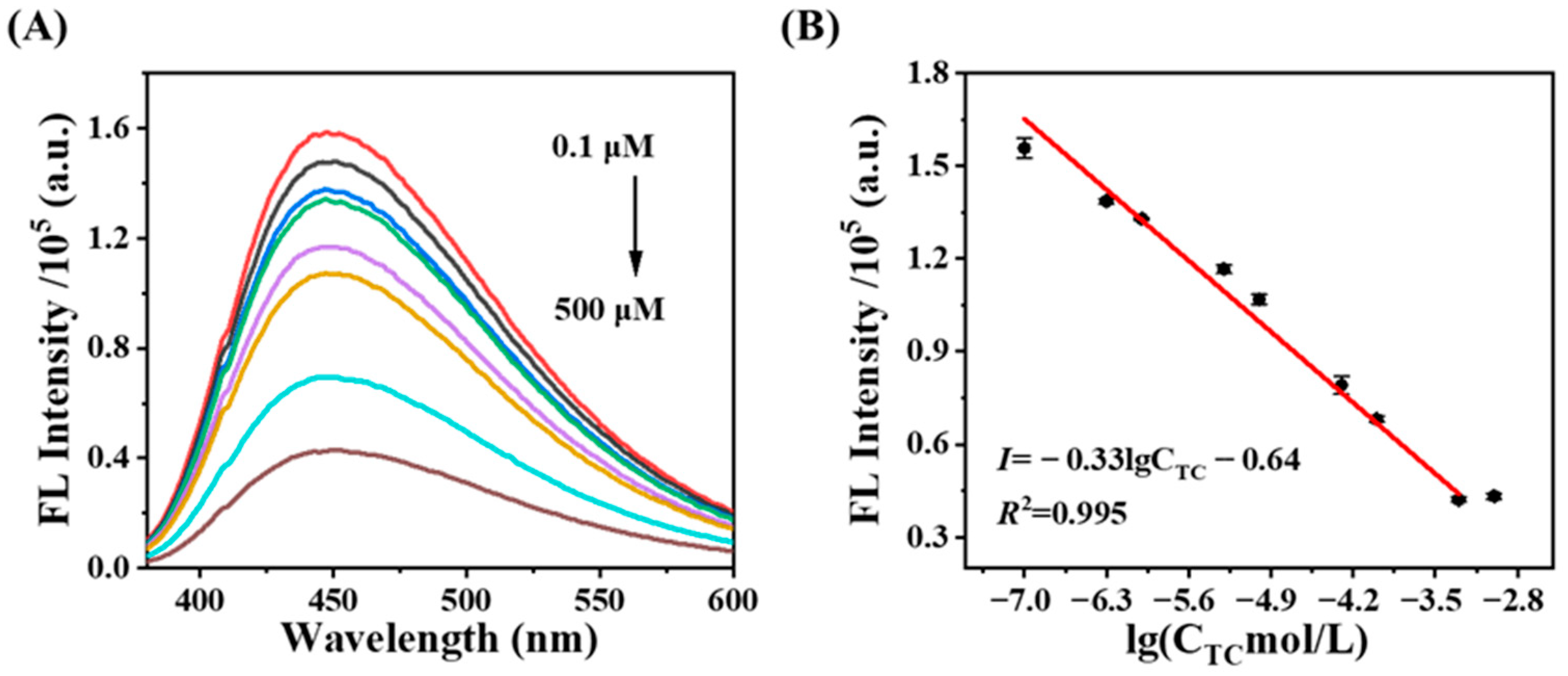

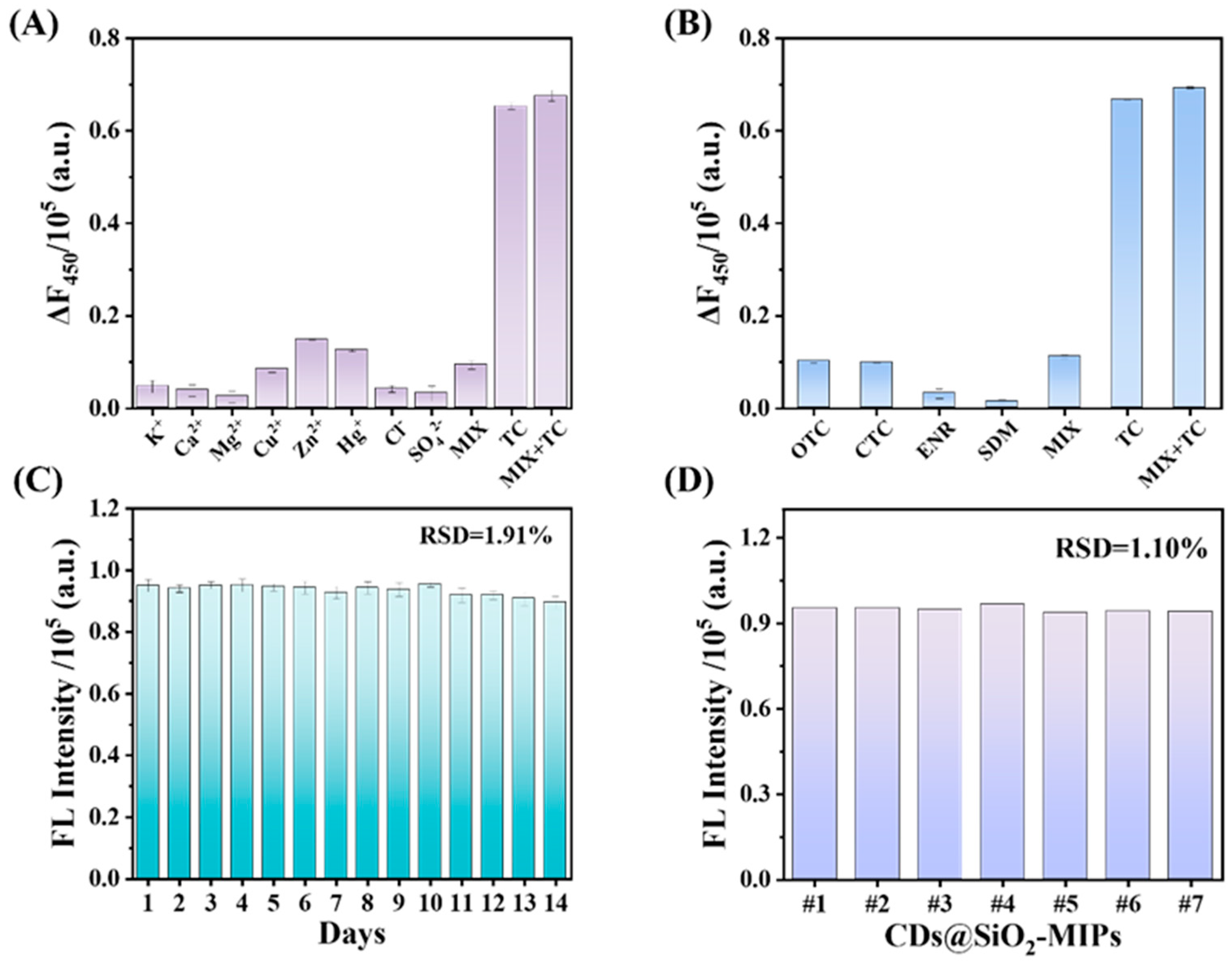
Disclaimer/Publisher’s Note: The statements, opinions and data contained in all publications are solely those of the individual author(s) and contributor(s) and not of MDPI and/or the editor(s). MDPI and/or the editor(s) disclaim responsibility for any injury to people or property resulting from any ideas, methods, instructions or products referred to in the content. |
© 2025 by the authors. Licensee MDPI, Basel, Switzerland. This article is an open access article distributed under the terms and conditions of the Creative Commons Attribution (CC BY) license (https://creativecommons.org/licenses/by/4.0/).
Share and Cite
Wang, X.; Wang, J.; Ji, G.; Zhu, Y.; Shi, J.; Zhang, M.; Tang, C.; Duan, H.; Dong, X.; Ola, O.; et al. Tetracycline Molecularly Imprinted Fluorescent Sensor Based on Tomato Stalk-Derived Carbon Dots. Sensors 2025, 25, 6993. https://doi.org/10.3390/s25226993
Wang X, Wang J, Ji G, Zhu Y, Shi J, Zhang M, Tang C, Duan H, Dong X, Ola O, et al. Tetracycline Molecularly Imprinted Fluorescent Sensor Based on Tomato Stalk-Derived Carbon Dots. Sensors. 2025; 25(22):6993. https://doi.org/10.3390/s25226993
Chicago/Turabian StyleWang, Xuejing, Jing Wang, Guanya Ji, Yihua Zhu, Jun Shi, Mengge Zhang, Chengshun Tang, Hongwei Duan, Xiuxiu Dong, Oluwafunmilola Ola, and et al. 2025. "Tetracycline Molecularly Imprinted Fluorescent Sensor Based on Tomato Stalk-Derived Carbon Dots" Sensors 25, no. 22: 6993. https://doi.org/10.3390/s25226993
APA StyleWang, X., Wang, J., Ji, G., Zhu, Y., Shi, J., Zhang, M., Tang, C., Duan, H., Dong, X., Ola, O., Liu, Q., & Niu, Q. (2025). Tetracycline Molecularly Imprinted Fluorescent Sensor Based on Tomato Stalk-Derived Carbon Dots. Sensors, 25(22), 6993. https://doi.org/10.3390/s25226993





